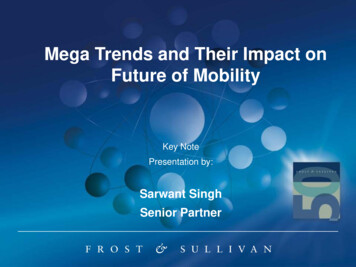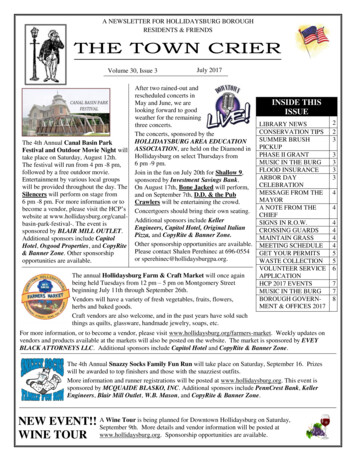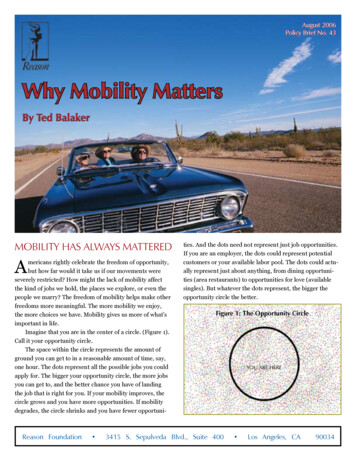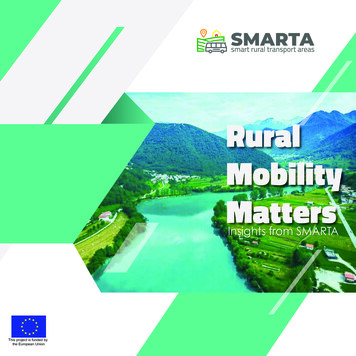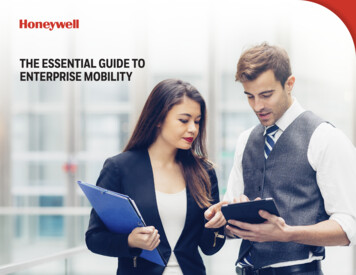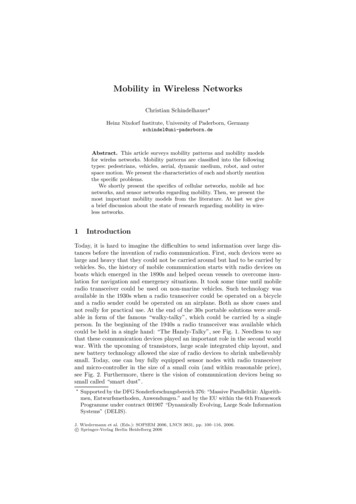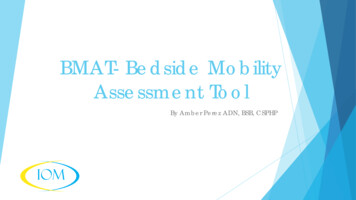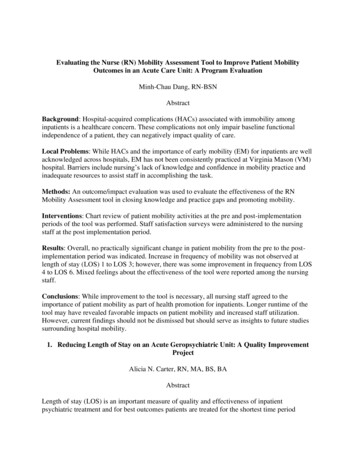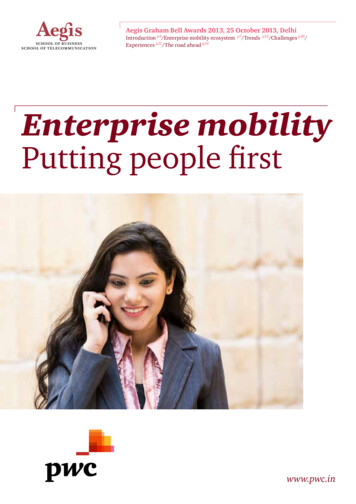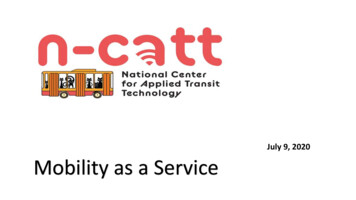
Transcription
July 9, 2020Mobility as a Service
National Technical Assistance Center Launched in late 2019 Operated by Community TransportationAssociation of America Through a cooperative agreement with theFederal Transit Administration (FTA)
N-CATT’s mission is to provide small-urban,rural, and tribal transit agencies with practical,replicable resources that help them applytechnological solutions and innovations.N-CATT is carrying out this mission byanalyzing information, communicating it,helping transit systems plan, and encouragingimplementation of cost-effective, value-addingtechnology.
FIND US AThttps://n-catt.org/
Mobility as a Service(MaaS)Carol SchweigerPresident, Schweiger ConsultingN-CATT WebinarThursday, July 9, 20205
PRESENTATION OUTLINEMobility management MaaS?What is Mobility asa Service (MaaS)and is it related toMobilityManagement?010302MaaS in the ruralenvironmentSchweiger Consulting05Roadmap,Readiness andEvaluation04What is UniversalMaaS?2
DEFINITIONSMobility as aService (MaaS)An integrated mobility concept in which travelers can access theirtransportation modes over a single digital interface. MaaS primarily focuseson passenger mobility allowing travelers to seamlessly plan, book, and payfor travel on a pay-as-you-go and/or subscription basis.Mobility onDemandA concept based on the principle that transportation is a commodity wheremodes have distinguishable economic values. MOD enables customers toaccess mobility, goods, and services on demand. – Not MaaSShared MobilityMobilityManagementSchweiger ConsultingThe shared use of a travel mode that provides travelers with access to atransportation mode on an as-needed basis. – Not MaaSAn innovative approach for managing and delivering coordinatedtransportation services to customers, including older adults, people withdisabilities, and individuals with lower incomes. – Not MaaS7
Traveler-centric – promotes choice in personal mobility driven by thespecific needs of the traveler and utilizes universal design principles tocapture the needs of all travelers.Mode-agnostic – encourages multimodal connectivity and systeminteroperability where all modes of travel are considered and integratedseamlessly to achieve the complete trip vision.Technology-enabled – leverages emerging and existing technologies, dataconnectivity, and standardization to support personal mobility choices.Partnership driven – develop and leverage unique partnerships,both public and private, to accelerate deployment of emergingmobility options.Bob Sheehan, “Mobility Marketplace Connecting Trips for All,”International Conference on Demand Responsive and InnovativeTransportation Services, Tuesday, April 16, 2019, Baltimore, MDMobility Innovation Principles
SUPPLY4Bob Sheehan, “Mobility Marketplace Connecting Trips for All,”International Conference on Demand Responsive and InnovativeTransportation Services, Tuesday, April 16, 2019, Baltimore, MDDEMAND
Bob Sheehan, “Mobility Marketplace Connecting Trips for All,”International Conference on Demand Responsive and InnovativeTransportation Services, Tuesday, April 16, 2019, Baltimore, MDHolistic View and Enablers
Schweiger Consulting11
MAAS SERVICE COMBINATIONS FORDIFFERENT GEOGRAPHICAL AREASIncrease efficiency andutilization rate Maintain sufficient service level Improve accessibilityBased on: Demand-responsive transport, taxis,buses and connections to long-haultransport, and car pooling Additional services: parcel deliveries,library services, and food and medicinedistribution No need for a 2nd car First-/last-mile accessibility Urban MaaS Objectives Reduce the use private of cars(congestion, parking) Reduce emissionsBased on: (1) Existing public transport; and (2)Extended with rental and shared cars andbikes Schweiger ConsultingAki Aapaoja, “MaaS service combinations fordifferent geographical areas,” 24th World Congress on IntelligentTransportation Systems, 29 October - 2 November 2017, Montreal, CanadaSuburban MaaS ObjectivesRural MaaS ObjectivesMaaS inDifferentGeographic AreasBased on: Park & ride -services, on-demandtransport and other services connectingsuburban to city transport servicesNational and InternationalMaaS Objective Offer easy all-in-one packagesBased on: (1) Long-haul transport including airtraffic; and (2) Additional services:accommodation, event tickets, activities 12
Schweiger Consulting13Aki Aapaoja, “MaaS service combinations fordifferent geographical areas,” 24th World Congress on IntelligentTransportation Systems, 29 October - 2 November 2017, Montreal, Canada
RURAL AREAS MOBILITY CHOICESUSING MOBILITY EQUITY INDICATORS Because flexible, high-occupancy modesbest suit the needs of a rural community,rideshare receives high priority Where practical, active transportation ranksas high priority due to need for safe bikingand walking infrastructure Personal electric vehicles receive highpriority, due to dispersed housing anddestinations Both electric and conventional public transithave medium priority, due to efficiency Carshare, ride-sourcing, bikeshare and taxisare ranked low, mostly due to lack ofaccessibility and feasibilityHana Creger, Joel Espino and Alvaro S. Sanchez, “Mobility Equity Framework: How to Make TransportationWork for People,” The Greenlining Institute, MobilityEquity-Framework-Final.pdfSchweiger Consulting14
SHARED MOBILITY STRATEGY TO BOOSTMOBILITY SUPPLY IN RURAL COMMUNITIESRidersProvide: Payingfor gasBenefits: Schweiger ConsultingEligible forride atures: ionsPhone dispatchPays mileagereimbursementGuaranteedrideDriversProvide: Rides VolunteerservicesBenefits: Earning money– mileagereimbursementHelping peopleSource: Dwight Mengel,Tompkins County Deptof Social Services15
MOBILITY MANAGEMENTCONCEPTMobilityManagementAdditional ditional Mobility Servicesmay include other regional transitservices, carsharing, car rental,carpooling, vanpooling, etc.Personalized Services mayinclude personalized tripplanning, real-time informationand booking, and service levelagreementFacilitators may include opendata, incentives and integratedpaymentSchweiger ConsultingFixed-Route andParatransit ServiceTravelerEnablersConnected LivingEnablers may include regionalservice coordination, real-timetransportation management andcustomer serviceConnected Living may includeaccess to healthcare, educationand government services16
MOBILITY MANAGEMENT NEEDSTechnology Needs Multimodal trip planning, reservation and payment through mobile applications and other means for those without mobile devices Regional real-time transportation information Account-based payment system that includes options for the unbanked Operations management tools for other mobility service providers Interfaces with other regional mobility service providers (e.g., State DOT District Office)Policy and Partnership Needs Cooperate and coordinate with other regional mobility services including transit, paratransit, car rental, carsharing, carpool, vanpool, etc. Institute fare caps (charge the least for a multimodal trip as is available) Partner with non-transportation entities (e.g., healthcare providers, educational institutions, local attractions) Establish incentive or customer loyalty programData and Reporting Needs Open data for multimodal trip planning and real-time information Data reflecting trip making patterns (e.g., origin-destination data) Performance measures for each mobility service, including how much each mobility service supports transit services State DOT and FTA reportingSchweiger Consulting17
GUIDING PRINCIPLES FORMOBILITY MANAGEMENT Collaboration –ensure continualtransport improvement Safety –must be consistent withregion’s safety goals Transit –must complement andhelp to satisfy needs of publictransport Congestion –impact on traffic,public transport, mode choiceand roadway safety Sustainability –must help attaingreenhouse gas (GHG)emissions and reduction goals Equitable access –must beaccessible to all people Accountability –must share datafor region and public to determineservices’ benefits and impacts ontransport, and whether or notservices’ meet region’s transportgoals Labor –must be consistent with fairlabor and pay practices andpolicies Disabled access – must beaccessible to disabled persons Financial impact –demonstratehaving a positive financial impacton transport investmentsAdapted from “10 Guiding Principles,” anel-guiding-principlesSchweiger Consulting18
MAAS IS A SOLUTION. WHAT’STHE PROBLEM?MaaS is not about getting rid of private cars. Excluding private cars from multimodalitywould make MaaS a zero-sum game.MaaS is about accelerating modal shift from private cars to shared resourcesIs it realistic to think that MaaS would make people give up their cars in rural areas? At leastgiving up the second car from the family becomes an option.How many different forms of transport you use to get where you are going is irrelevant. Therelevant factor is the private vehicle, which is and will be an essential part of the systemIn rural areas, the reason for driving is obvious: poor or non-existing public transport and noother services beside the taxi, which is not an option for many.Pekka Möttö, “MaaS is a solution. What’s the problem?” The Urban Mobility Daily, April 18, 2019, whats-theproblem/#: :text ravel%20chain%20either.&text not%20including%20your%20own%20vehicle.Schweiger Consulting19
MAAS IS A SOLUTION. WHAT’STHE PROBLEM? (2)Solutions based on modern technology can provide immediate, easily understandable benefits to rural areas.Public transport and other shared services can be arranged on platforms more cost effectively (and at a reasonablecost to the traveler) with demand-responsive flexible shared ride technology.What makes the rural solutions MaaS? Integration. All existing services integrated in one easy-to-use application,including new demand-responsive services and sharing servicesNeed for multimodality means different needs at different times. MaaS is meant to identify the individual mobilityneeds and provide a multimodal solution for them.Example: using minibuses dedicated to 1 purpose to serve others at the same time by making empty seat capacityavailable for other users as. Making more efficient use of the volunteer driver schemes is also one part of thesynergy.MaaS is customer-centric, has potential to provide new ways of reselling, packaging, branding and pricing, and istechnology-enabled mobility service offering, which is more flexible and individual than traditional public transportSchweiger Consulting20
UNIVERSAL MOBILITY AS A SERVICEWhy? Result of our 2-ClassTransportation SystemWhat: Universal MaaS Advance reservation requirements Inadequate funding & programmaticrules trip and trip purpose limits Unreliable pick-up/drop-off times Jurisdictional boundaries becomearbitrary barriers Fragmentation Inefficiency due to rules & regulations A single, integrated network oftraditional and non-traditionalservices that together serveEVERYONE Universal Design With or without AVs One stop shopping‣‣‣‣Easy DiscoveryEasy BookingEasy Mode TransfersEasy PaymentFrom Jana Lynott, AICP, Senior Policy Advisor, “Universal Mobility as a Service,” International Conference on Demand Responsive and Innovative TransportationServices, Tuesday, April 16, 2019, Baltimore, MDSchweiger Consulting21
An OpenPlatformFutureFrom Jana Lynott, AICP, Senior Policy Advisor, “Universal Mobility as a Service,” International Conference on Demand Responsive and Innovative TransportationServices, Tuesday, April 16, 2019, Baltimore, MD
A WalledGardenMobilityFuture CC BY-SA Kevin ChambersFrom Jana Lynott, AICP, Senior Policy Advisor, “Universal Mobility as a Service,” International Conference on Demand Responsive and Innovative TransportationServices, Tuesday, April 16, 2019, Baltimore, MD
GREATER DAYTON REGIONALTRANSIT AUTHORITY MAASMaaS ProviderFRAMEWORKGoals: Seamless Regional MobilityEcosystem Equitable Access Open Data Integrated Payment “All mobility providers willcollaborate with us deliveringone unified mobility network viaDayton MaaS CustomerOpenAPI/DataTripCompletionMobility ServiceProvidersAdapted from Santosh Mishra, IBI Group and Nick Mantia, RTA, “Mass Transit to MaaS Transit: Are We Ready?” presentation to 2018 APTA Fare Collection/RevenueManagement & TransITech Conferences, DaytonRTA FarePaymentSolsSys.pdfSchweiger Consulting24
MICHIGAN MOBILITY CHALLENGE RIDES-A-GOGO MOBILITYCOORDINATION PROJECT 3 transit agencies: Bay Area Transportation Authority(BATA), Benzie Bus and Allegan CountyTransportation Many lessons learned:o Software and Technology Integrationo Regional Participation and Agency-SpecificNeedso Creating Something from Scratch vs. an Off theShelf Producto Budget and Scopeo Start-up vs. Corporateo Customization and FlexibilitySchweiger Consulting25
Potential MaaS Development Cycle: Example from Dallas AreaRapid Transit MaaS DefinitionPersonalized journey planning and managementHassle-free digital payment and ticketingFirst/Last mile transportation combining publictransit, on-demand and shared mobility servicesOptimization of data exchange to expand servicesPhase I(Emphasis on sharing, integrationsand evaluations)Piloting ProgramsP3 s“Mobility as aService”HighResourcePlanningMobility BehaviorInfrastructureAutomatedVehiclesPhase II(Emphasis onautomated driving)BusinessModelingLevel ofvalueSharedIntermodalMobilityRide Hailing, Bike,Scooter & Carsharing2014Point of Entry2021 2030 LowSource: Roland Berger – Global Strategy Consulting Firm
We built a tool to assess market readiness Customer demandMaaS Readiness IndexTransport service availabilityGovernment and regulatoryAndrew Somers, “Mobility as a Service,” 23rd World Congress on Intelligent Transport Systems, SessionES10, Melbourne, Australia, 10-14 October 2016.27
KEY PERFORMANCEINDICATOR EXAMPLESEcological effects Economic effectsSocietal levele.g. ”Transport’s releaseof greenhouse gases”OrganizationallevelTraveller levele.g. ”Number of trips perindividual and month”Societaleffectse.g. ”Society’s cost fortransport”e.g. ”Accessibility totransport”e.g. ”The service’sprofitability”e.g. ”New jobs”e.g. ”Monthly cost for anindividual’s trips”e.g. ”Perceivedaccessibility todestinations like work”Ref: Karlsson et al. 2019Jana Sochor, ICoMaaS, December 3-4, 2019, Tampere, Finlandhttps://kompis.me/framework/
RESOURCES USDOT ITS JPO, MOD Webinar #6: Micromobility Marketplace: Integration,Integration, Integration, June 17, 2020,https://www.pcb.its.dot.gov/t3/s200617 MOD Series 6 Mobility Marketplace Integration.aspx Carol Schweiger, “Bringing Mobility as a Service to the U.S.: AccessibilityOpportunities and Challenges,” white paper prepared for the National Aging andDisability Transportation Center (NADTC), erations-Final.pdf MaaS Alliance Library, https://maas-alliance.eu/library/ “Main challenges associated with MaaS & Approaches for overcoming them,”MaaS Alliance, /2019/02/Main-challenges-pdf.pdf Ranjit Godavarthy, Jill Hough, Sean Libberton and Russell Koff,“Opportunities forState DOTs (and others) to Encourage Shared-Use Mobility Practices in RuralAreas,” Prepared for National Cooperative Highway Research Program,Transportation Research Board, Project No: NCHRP 20-65 Task /Task76Report.pdf Andrew Somers and Hany Eldaly, “IS AUSTRALIA READY FOR MOBILITY AS ASERVICE?” ARRB Conference, 27th, 2016, Melbourne, Victoria, hResults.aspx?q TWFhUyByZWFkaW5lc3MgaW5kZXg%3dSchweiger Consulting29
RESOURCES (CONT’D) Bosch, “MMC SPLT Rides - Lessons Learned,” Michigan Mobility Challenge,May 8, 2020,https://www.michigan.gov/documents/mdot/MMC Lessons Learned SPLTBosch v3 690567 7.pdf Jenni Eckhardta, Lasse Nykänena, Aki Aapaojaa and Petri Niemib, “MaaSin rural areas - case Finland,” Research in Transportation Business &Management 27 (2018) cle/pii/S2210539518300403 Hana Creger, Joel Espino and Alvaro S. Sanchez, “Mobility EquityFramework: How to Make Transportation Work for People,” The GreenliningInstitute, MobilityEquity-Framework-Final.pdf Taxonomy of Shared Mobility – SAE 3/ VTT Technical Research Centre of Finland Ltd, “Mobility as a Service(MaaS) in rural context,” -context/Schweiger Consulting30
THANK YOU!Carol SchweigerPresidentSchweiger Consulting LLC781-424-2208carol@tech4transit.comSchweiger Consulting31
Developing Mobility-as-a-ServiceServing Small Urban & Rural CommunitiesTompkins County, New YorkN-CATT: Rural Mobility-as-a-Service Webinar: July 9, 2020
Mobility-as-a-Service Combinemulti-modal trip planning, customer service andintegrated mobility services to meet customer needs.Why Tompkins County, NY? Homegrownidea. First presented on June 19, 2010. Extensive Mobility Management Programs Shared-use mobility services & non-profit mobility sector Public transit & County support. Collaborative culture.
Family of Mobility Services
MaaS Phase 1 Multi-Modal Trip Planning Rural Mobility Services Multi-Modal Customer ServiceMaaS Phase 2 Member Organization Financial Services Annual Mobility Budget Monthly Payments Include third-partypayments for trips andsubsidies.
Multi-Modal TripPlanning Bus Services: Intercity Commuter Local (TCAT) Shared-Use Services Ithaca CarshareBikeshareParatransit (Gadabout)TaxiTNC’s (Lyft & Uber)
Increase Supply ofRural Mobility Services1. Volunteer Transportation Services2. Rideshare (Carpooling)3. TCAT First/Last Mile Service Pilot(T-Connect)
TCAT First Mile/Last Mile Pilot2019-2022People may schedule a ride, by app or phone call,to a minibus from their residence in rural areastransfer seamlessly to a TCAT bus.Created an app will to determine if service isavailable within the time and destinationparameters submitted and will display the closestmatching trips. App continuously informs busoperators and passengers of trip status.County mobility management program conductspublic outreach, surveys, and rider education forthe before, during and after the pilot.
Watch Way2Go Videos:Five Fabulous WaysAging, Driving and FamilyConversationsIthaca Carshare BasicsTaxi BasicsTCAT Bus BasicsTCAT Bus Basics for Wheel ChairUsersTransit App ToolsUsing the Bus Bicycle RackWheelchair Users You've GotOptionsWhy and how to share more ridesWay2Go Resources and Videos areavailable in Spanish and Chinese.Recursos en español中文资源Multi-Modal 24/7Customer Service Way2Go Mobility Education MaaS Information & 24/7Customer Service Center Ithaca Carshare & 211 Information& Referral App and Phone Enhanced Guaranteed RideMembership Rescue from Trip Failures
MaaS Phase 1 Pilot Business Model Canvas Key Partnerships Transport Providers:TCATGadaboutIthaca CarshareFISH deshareTNCs Other stakeholders: County DSS Way2go ITCTC (MPO) Go Ithaca! Key ActivitiesPartnershipsCommunity educationMaaS Call CenterMarketing & GuaranteedRide SalesPilot Evaluation Value Propositions Multi-modal trip planningRural Mobility ServicesMulti-modal CustomerServiceGuaranteed rideData Privacy Policy &Security Existing customer base(Carshare & TCAT) 211 Info/Referral Communitytransportation education(Way2go)Staff salariesApp Design, Tech Procurement Plan/ConsultantDevelopment, Operations, Data Collection for EvaluationOverhead (rent, utilities, insurance, IT, etc.) Concierge Service 24/7 - Trip Planning / ServiceInformation - Customer Services Feedback to mobilityoperators Key ResourcesCost StructureCustomer RelationshipsChannels Website / Phone App Phone calls Office visits Human Services /Social ServicesAgencies Revenue StreamsCustomer service feeGuaranteed ride annual membership feeFederal IMI Grant (3/16/2020)Other Federal& State grants Customer Segments Public transit users College students Carshare members Families Seniors, people withdisabilities, and lowincome People who do notdrive or own a car Eco-friendly, anti-GHG Public & HumanServices Clients Community-mindedrural residents
Business RiskAs of June 2020, on a scale of 0-10 (low–high risk), this is how we rateour risk for Phases 1 & 2. Phase 1: 3 (low risk) We know exactly what we want the multimodal trip planning & customer service app to do. We will be able toorganize the customer service center. Phase 2: 8 (high risk) Many unknowns and much work needed tocreate robust, secure financial management policies & operationsto be successful & sustainable. There’s opportunities for partnershipwith an individual mobility account system under development.
2020-2021 Funding FTA Integrated Mobility Innovation (IMI) Program 820,000 awarded to County on 3/16/2020 NYSERDA (New York State Energy Research &Development Authority) 205,000 awarded to TCAT Transit System forfirst/last mile pilot program as 20% non-federal match.
Lessons Learned1. Split MaaS into two phases. We created Phase 1: multi-modal trip planning, support first/last mile project, & multimodal customer service, including a call center.2. Select a lead agency for Phase 1. County Transportation Planning will lead Phase 1 starting in September 2020.The local MaaS team will then meet formally to develop the project.3.Advance innovative practices in rural mobility and service delivery. We need to expand the supply of service in rural communities, includingvolunteer transportation, carpool, first mile/last mile service and guaranteed ride. We will work with public sector & non-profit human service agencies to improvemobility service for clients.4. Don’t overpromise. Under-promise and over-deliver. Assist customers with trip-failures. Trust building is core value proposition for a MaaS start-up.
Dwight Mengel, Chief Transportation Planner,Tompkins County Dept of Social Services, Ithaca, NY(607) 274-5605 / dwight.mengel@dfa.state.ny.usWenzheng Li, PhD student, Department of City & RegionalPlanning, Cornell University, Ithaca, NY(607) 262-5497 / wl563@cornell.eduTompkins MaaS Team
Ecosystems of Shared Mobilityin the San Joaquin ValleyCaroline Rodier, Ph.D.Institute of Transportation Studies, UC DavisN-CATT WebinarJuly 9, 2020
Overview San Joaquin Valley Motivating Problem Community-Based Planning Study Mobility as a Service (MaaS) Next Steps for MaaS
California’s San Joaquin ValleyGeographic Background
“The foodbasket of theworld.”
Economically andEnvironmentallyDisadvantagedCommunities
Access, Poverty and Emissionsin Rural CaliforniaThe Problem
Challenges to Rural Transit ServiceDevelopmentPatternsLong TravelDistancesLow TransitRidershipHigh TransitCostsLow TransitService
Rural Households Living in PovertyLow TransitServiceHigh AutoOwnershipCostsLow AccesstoOpportunity
Criteria &GHGsemissions
Community Based Planning to SupportAlternatives to Personal Car OwnershipOrigin Story
Community-Based Planning Engagement and data analysis Inventory accessibility challenges: Intercity transit service gaps High service costs Low farebox Low auto ownership levels Identify new technology and shared mobility alternatives Evaluate alternatives: Reduce service costs Improve access Support high-quality fixed-route transit Reduce auto ownership and emissions
Geographic Locations of Pilots in theSan Joaquin Valley MaaS Volunteer Rides EV Carsharingat AffordableHousing
Volunteer Ride-Hailing Service Free rides to residents by volunteer drivers Trips begin/end in disadvantaged rural areasAnd not served by transit As volume of rides grow, so does ridesharing Volunteer reimbursed @ IRS rate round trip Local non-profit (MOVES): recruit and trains drivers The Volunteer Transportation Center: Back-office,dispatch, routing Reserved up to 2 days in advance via MaaS
Mobility as a Service or MaaSOur Case Study Perspective
What is a MaaS system? User PerspectiveUser NeedsMaaS AnswersBest way to get from A to B?Rank multimodal options by time and cost.Arrival time?Real-time modal informationSpace available?If yes, then reserve.Pay now?If yes, then pay.
What is MaaS?System Perspective
How do computers communicate?By using open APIs or applicationprogram interface: Request and receive data Ask questions and Receive answersEfficient integration requires standarddata and open API: Work in progressService BAPIService ADataQ/AAPIService CAPIAPIMaaS Platform
Private MaaS in US Uber and Lyft Apps Include services they operate Transit included in some major urban areas User preselects mode: ride-hail carsharing electric scooter or bike transit Current can’t plan a trip with a combination of modes,but they are working on it e.g., e-bike to transit to ride-hail from A to BThe Verge 4/11/18
Potential of Public MaaS All Available Services Combined to provide more choices Minimize travel time and cost givenuser need Public Facing Platform Lower barriers to market entry,especially to small local providers Increase service supply Lower cost through more competition Individual accounts and codes Allow for promotions Easy application of subsidies forspecial groups (i.e., disabled,seniors) Fixed Route Bus and Train Ridehailing (Uber, Lyft, and Taxi) On-demand ridesharing(Microtransit, Wave) Scheduled ridesharing (VolunteerRides, Car/Vanpools) Vehicle Sharing (Car, Bike,Scooter) Open Seats on SpecializedShuttles (Healthcare andRetirement) Walk Personal Bike and Car
Vamos: Short Term Goals Increase awareness of transit services Integration of transit services Across transit agencies Fixed-route with DRT (dial-a-ride, deviated transit, microtransit) Transit with community-based shared mobility (VOGO, Miocar) VOGO and DRT Reservations Streamline transit payments and subsidies
Vamos Status Today Transit planning with Open Trip Planner (14 transit agencies):: Fixed transit Demand-responsive transit (dial-a-ride and deviatedshuttles) Microtransit (VanGO!) Walk access (with turn by turn instructions) Real-time arrival and departure when available Bicycle trip planning VOGO reservations
Local Transit and Regional Agencies InvolvedSAN JOAQUIN COUNTYSTANISLAUS COUNTYREGIONAL RAILSan Joaquin RegionalTransit District (RTD)Stanislaus County PublicWorks - Transit (StaRT)AMTRAKCity of EscalonMOVE StanislausCity of Manteca TransitModesto Area Express(MAX)Ripon Blossom ExpressModesto Area Dial-A-RideCity of Lodi GrapeLineCity of Turlock TransitCity of Tracy TracerCeres Dial-A-Ride (CDAR)ACE commuter
Inter-County Transit Trip Plan Stockton to Modesto Real time MAX bus info Plan trip now or in advance Turn by turn walk directions
Manteca, San Joaquin County Microtransit service: VanGO! Bike route and directions
Riverbank to Modesto,Stanislaus County Deviated shuttle, bus with realtime info, and walk combo Bike route and directions
VOGO ReservationsRiverbank to Modesto,Stanislaus County Deviated shuttle, bus with realtime info, and walk combo Bike route and directions
Next Steps for Vamos With funds from the FTA’s Innovative Mobility Initiative: Integrate fare payment with transit planning Standardize integration (data and APIs) with other mobility services(e.g., carsharing, ridehailing, microtransit) Evaluate feasibility of implementing MaaS with rural collective. The cost of implementing MaaS may be reasonable for a major city butnot for individual small rural communities.
Project Partners!
Thank you! More questions: Caroline Rodier cjrodier@ucdavis.edu
Sheryl Gross-Glaser – grossglaser@ctaa.orgCarol Schweiger – carol@tech4transit.comDwight Mengel – Dwight.Mengel@dfa.state.ny.usCaroline Rodier – cjrodier@ucdavis.eduFIND US AT https://n-catt.org/
Intermodal Integrations Payment Integrations Piloting Programs P3 Agreements Automated Vehicles Low Level of value Resource Planning Infrastructure Shared Intermodal Mobility High MaaS Definition Personalized journey planning and management Hassle-free digital payment and ticketing First/Last mile transportation combining public
